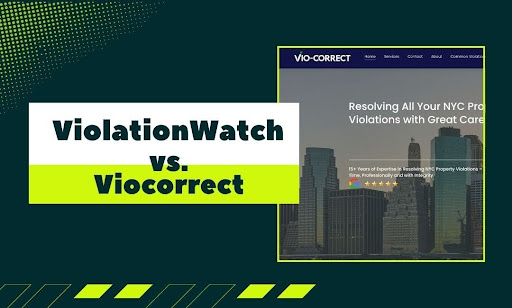What’s slowing down your violation resolution process isn’t just red tape—it’s the wrong tech stack. Most platforms promise automation. Few reduce your workload. The truth? Some tools add friction where you need speed. Others bury the data you need under useless dashboards and bloated interfaces.
If you’re switching between spreadsheets, portals, and email chains to chase a single DOB or HPD update… something’s broken. This comparison cuts through the noise. We’re putting ViolationWatch and Viocorrect side by side—feature for feature—to show you which one actually supports efficient, portfolio-wide violation management in NYC.
You’re not here to explore bells and whistles. You’re here to get stuff done faster—with fewer surprises, better oversight, and fewer fines.
Here’s what we’re breaking down:
- Which platform tracks more NYC agencies—and how that affects your day-to-day oversight
- The difference in dashboards—which one surfaces what matters and buries what doesn’t
- Who sends alerts in time to act, not react
- Automation that actually works vs. automation that gets in the way
- Resolution workflows that close violations faster
- Which platform plays nicer with your internal team and documentation habits
- A clear verdict: Which one makes your property operations easier, not harder
No sales pitch. No generic reviews. Just real answers to the only question that matters: Which platform lets you manage property violations more efficiently? Let’s get into it.
Who Actually Tracks More NYC Agencies—and Why It Matters Every Day
Oversight isn’t about checking a few boxes. It’s about removing blind spots before they become fines. If a platform skips a city agency, you won’t see that violation coming. You’ll only hear about it when the deadline has passed, the cost has climbed, and your team is stuck in recovery mode. The platform you use must track everything you’re responsible for, across every agency that touches your building’s compliance profile.
Let’s break down who tracks what, and how that plays out where it counts.
What ViolationWatch Tracks
ViolationWatch pulls data from a full sweep of NYC enforcement and compliance agencies. That includes:
- DOB – permits, stop work orders, vacate orders, boiler corrections, and inspections
- HPD – litigation, emergency repairs, registrations, and Certificate of Correction notices
- FDNY – permits, violations, Certificates of Fitness, criminal summonses
- ECB – Environmental Control Board violations and court summonses
- DOH – health violations and tenant habitability risks
- DEP – boiler registrations and environmental violations
- DOT – sidewalk and roadway issues, trip hazards, non-compliance flags
- DSNY – sanitation violations and waste-related enforcement
- DEC – petroleum tank data and environmental compliance
- DOF – tax liens, property classification, and deed-related status changes
This kind of reach means no guesswork. If something is flagged, it shows up. That saves hours each week and cuts the chance of being blindsided by an agency you weren’t even tracking.
What Viocorrect Covers
Viocorrect focuses on violation resolution services, with a narrower scope of agency tracking.
They currently list:
- DOB violations
- FDNY violations
- HPD violations
- Sidewalk violations (DOT)
- Certificates of Correction
- Vacate and Stop Work Orders
- Defaulted fine reduction
- Limited and standard alteration applications
These are important. But the tracking doesn’t extend across agencies like DEC, DOF, DOH, or DSNY. That leaves you responsible for filling those gaps manually—or risking noncompliance if something slips through.
Why This Affects Your Workflow
If your platform isn’t pulling in data from all the agencies issuing violations, you’ll have to:
- Cross-reference multiple city portals
- Rely on delayed paper notices or OATH court reminders
- Chase updates through different channels and formats
- Waste time verifying if something even applies to your property
Widening the agency’s net tightens your compliance process. Narrow coverage? That leads to late reactions, missed hearings, and snowballing penalties.
The Dashboard That Cuts the Noise and Gets to the Point
A dashboard is only useful if it saves time. Not if it forces you to scroll, guess, or decode color-coded chaos. The difference comes down to what gets surfaced and what stays buried. Let’s look at how each platform presents your compliance data—and how that shapes what gets handled, escalated, or missed altogether.
Viocorrect’s Dashboard: Service-Driven, But Not Oversight-Focused
Viocorrect isn’t built around a real-time violation dashboard. Instead, it runs as a service portal, focusing on intake forms, specific violation types, and resolution services like Certificates of Correction, vacate orders, and fine reductions.
You’ll find dropdowns for:
- DOB, HPD, FDNY, and DOT issues
- Stop Work Orders and defaulted fines
- Alteration applications and court representation
But you won’t see live dashboards pulling fresh violations or updates automatically from NYC systems. There’s no centralized timeline, no dynamic analytics, no drill-down by address or agency. It’s more of a request-and-wait workflow than a self-directed compliance hub.
If you’re trying to track what’s new, what’s urgent, or what’s resolved, you’ll likely still need a spreadsheet—or multiple emails to support.
ViolationWatch’s Dashboard: Built for Action, Not Clicks
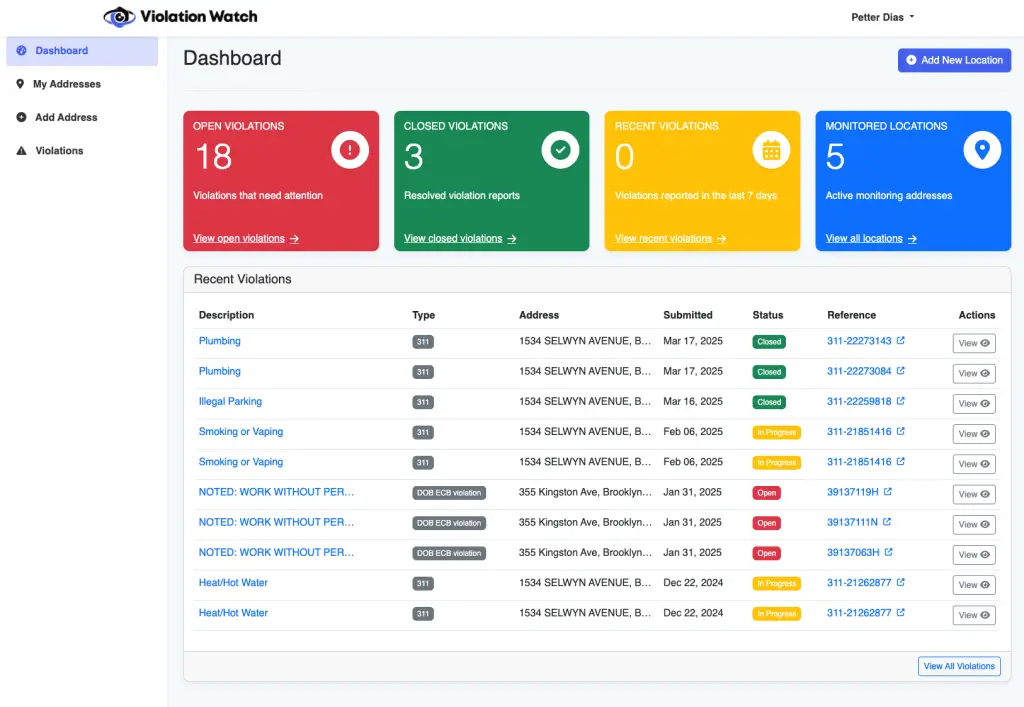
ViolationWatch’s dashboard doesn’t overload you with charts. It brings the most actionable data to the top, so you don’t waste time digging.
Here’s how it works, step by step:
- You sign up and add your properties: Just enter the address. The system pulls all relevant compliance sources automatically.
- The platform monitors violations across all NYC agencies: DOB, HPD, FDNY, DOT, DEP, DSNY, DOF, DEC—everything gets scanned in the background.
- Any new violation triggers an alert: You’ll get instant notifications by email or WhatsApp, with no delay.
- The dashboard separates violations by status: Open, closed, recent, and monitored—all broken down at a glance, color-coded, and sortable.
- You can dig into details without leaving the platform: Need the exact violation text, submission date, or agency reference link? It’s all there—next to the address and agency info.
- You act before fines escalate: No waiting for paper notices. No, wondering what’s missing. You’ve already seen it.
Dashboards aren’t about visuals—they’re about decisions. The faster you find what matters, the faster you fix it.
Alerts That Show Up When It Actually Matters
Getting notified after a fine hits your ledger doesn’t help. The right platform tells you what’s happening early enough to act, not clean up.
In NYC compliance, hours make a difference. Agencies don’t wait. Missed notifications lead to missed hearings, snowballing penalties, and unnecessary back-and-forth with tenants, lawyers, or contractors. If alerts lag—or worse, if they only show up in a cluttered inbox—it’s already too late.
Let’s break down who actually gets alerts to you on time.
Viocorrect’s Notification Approach
Viocorrect operates as a manual-first service. You submit violation info, request help, or start a correction file. Their role kicks in after you’ve received and recognized the violation.
That means:
- You’re responsible for tracking when a violation lands
- You need to submit a request for help managing it
- There’s no automated alerting system for new violations, court dates, or document updates
If your internal process doesn’t catch the violation, the system won’t catch it for you.
How ViolationWatch Handles Alerts
This platform was built to catch violations the moment they hit—before they cause damage.
Here’s how the alert system works:
- The system monitors all NYC agency data feeds around the clock: It picks up new filings, inspection results, summonses, and unresolved complaints in the background.

- As soon as a match hits your property profile, it triggers a notification: You don’t need to log in or check a feed. The alert comes straight to you.

- You get notified through multiple channels: SMS, WhatsApp, and email, sent to multiple addresses and numbers, so no one misses it.
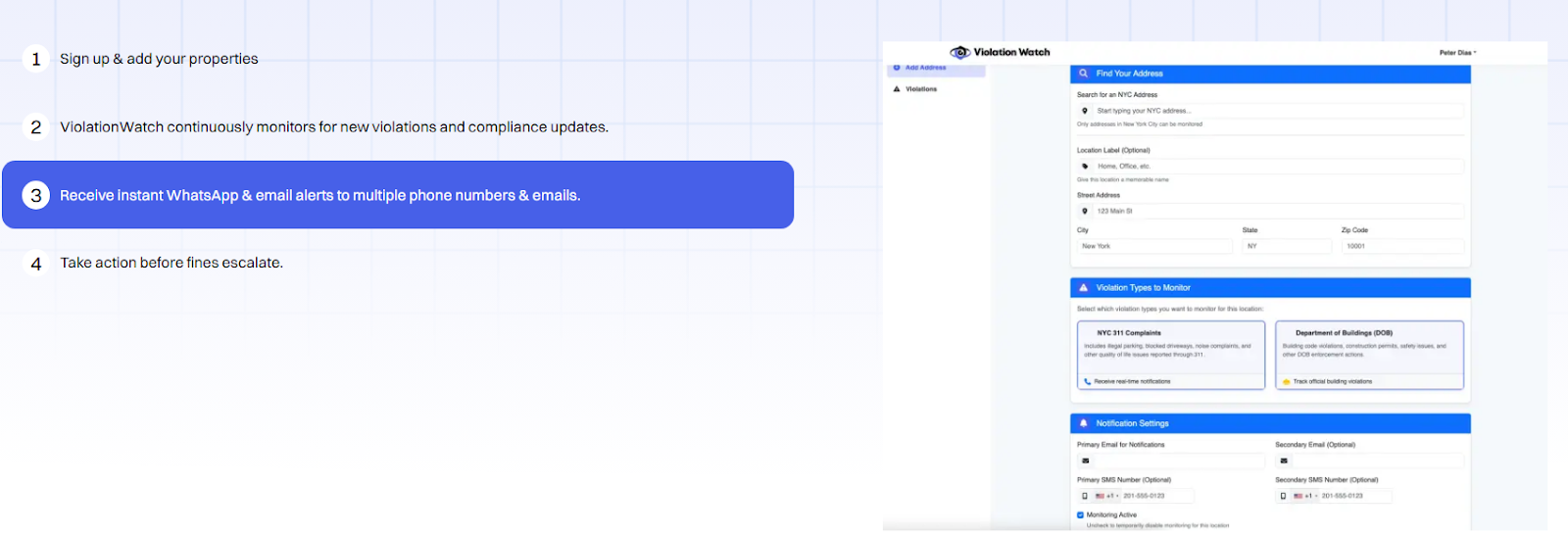
- Each alert includes context, source, and next steps: You’ll see what happened, who filed it, and what kind of response it needs—right from the alert.
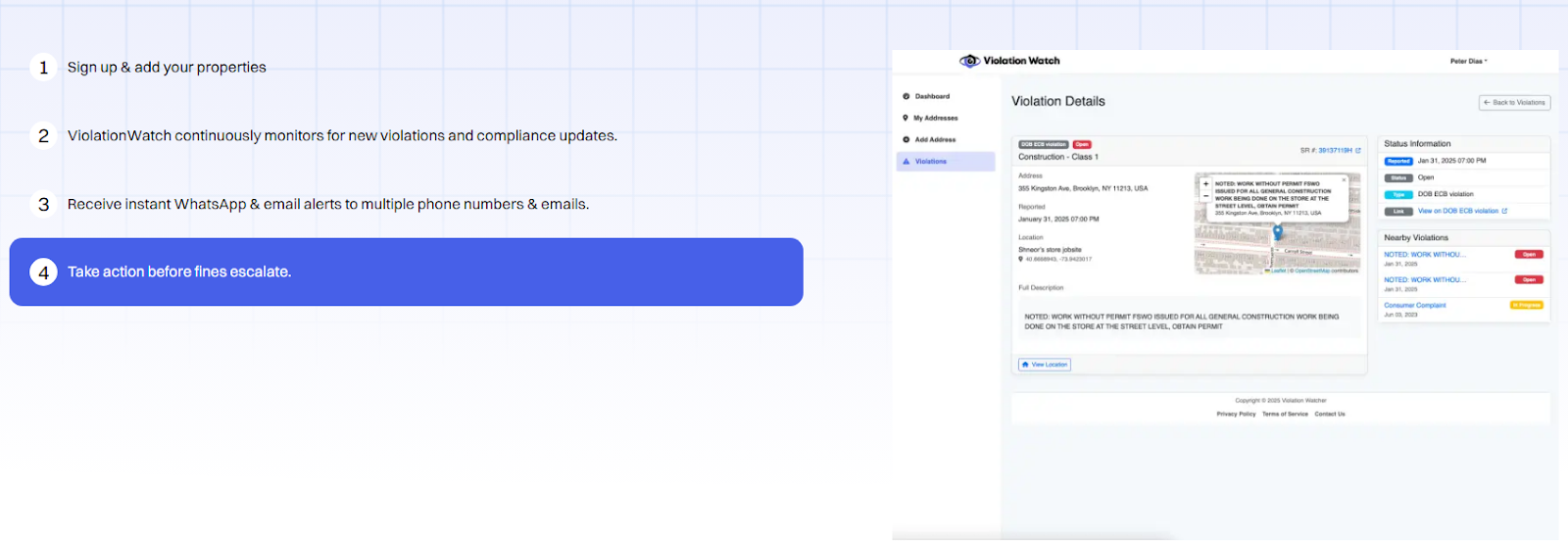
- You move immediately: No filtering through city portals. No waiting for paper mail. The information lands where your team can use it, without delays.
Timely alerts are the difference between controlling compliance and cleaning up after it.
Which Automation Actually Reduces Your Workload
Automation isn’t about fancy features. It’s about removing steps you shouldn’t have to touch. If a platform calls itself automated but still needs you to chase updates, enter data manually, or double-check deadlines, it’s not automation. It’s a to-do list dressed up as software.
Let’s break down how automation works (or doesn’t) inside each platform.
Vio-Correct’s Process Still Runs on User Input
Vio-Correct focuses on violation correction services, not proactive automation. Their model revolves around users initiating a request:
- You get the violation
- You decide to resolve it
- You select a service type from their dropdown
- You submit your information through a web form
- A human from their team takes it from there
There’s no backend that pulls your data into a dashboard, flags new violations, or refreshes agency statuses automatically. You’ll still be the one hunting violations across DOB, HPD, and FDNY sites—and that eats time fast.
It works if you’re reactive. But if your goal is proactive compliance, this workflow still leaves you doing the heavy lifting up front.
ViolationWatch Does the Tracking, Sorting, and Alerting for You
This system removes the busywork.
Once your property is added, the platform runs on its own. You don’t feed it data. It pulls what it needs from official NYC agency databases using automated scanning logic, and keeps going.
Here’s what that looks like:
- No form submissions required
- No spreadsheet uploads or manual imports
- No double-checking agency portals for missed violations
- No delay between violation issuance and notification
New filings appear in your dashboard automatically. Agency status changes are reflected in real-time. Every alert is tied to an actual violation, not a lagging batch import or a backend ticket queue.
You stay focused on decision-making. The platform handles everything else behind the scenes. That’s automation that actually earns its name.
What Fast Violation Resolution Actually Looks Like
Speed matters. Not because you’re racing the clock, but because every extra day with an open violation increases risk. Missed deadlines. Higher penalties. Delayed permits. Tenant complaints. Project stalls. But it’s not about how fast you move. It’s about how well the system helps you move faster without stumbling.
Let’s walk through how each tool approaches the resolution process—and how that impacts your ability to actually close violations.
Viocorrect’s Resolution Flow
Viocorrect works like a task-based service vendor. Here’s how things typically unfold:
- You select a violation type on their website
- Submit a request form manually
- Their team reviews and reaches out
- You collaborate via email or phone to process filings
- They handle paperwork like Certificates of Correction, affidavits, or LAA forms
You’re leaning heavily on human coordination. That’s fine for simple requests. But when you’re juggling multiple properties—or trying to resolve violations across different agencies—it can slow things down. Especially if you’re waiting for a callback, a quote, or clarification.
It’s less of a workflow and more of a ticketing experience.
ViolationWatch’s Approach to Faster Closures
ViolationWatch flips the script. Instead of waiting for you to start the process, it:
- Flags which violations are open—and which ones are urgent
- Connects those violations to resolution resources instantly
- Surfaces document templates, submission steps, and response deadlines—right in the dashboard
- Keeps all violation details, agency contact links, and attachments in one place
- Tracks closure progress automatically, so you’re not following up on what’s already done
The system doesn’t just alert you. It guides you through, with built-in workflows designed around how NYC actually processes compliance. It’s not just faster—it’s cleaner. You don’t have to ask what’s next. You see it.
The right platform won’t wait for you to initiate the fix. It should bring the fix to you, and clear the path to close violations without chasing steps.
Internal Teams Need Tools That Fit How They Already Work
Compliance isn’t handled by one person. It’s a team sport—property managers, compliance admins, legal staff, contractors, and sometimes even owners all touch the process. So the platform you use needs to work with your team’s habits, not force a new workflow from scratch.
Let’s talk about system flexibility, collaboration, and documentation.
Viocorrect’s Approach to Collaboration
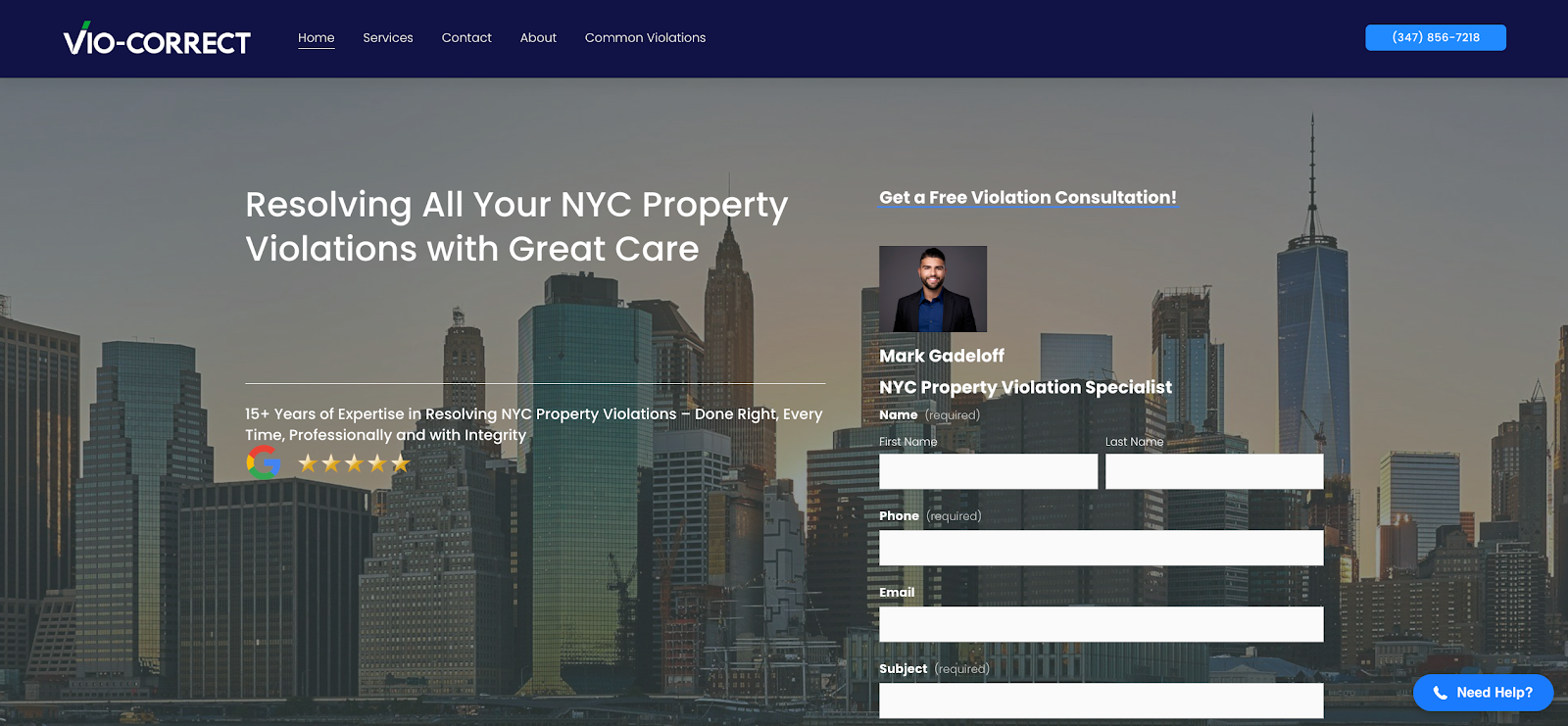
Viocorrect isn’t built around multi-user collaboration. The interface is service-forward. One person fills out a form. One person gets a response. And everything moves through a traditional support pipeline—email threads, follow-up calls, or scheduled consults.
There’s no dashboard visibility for multiple team members. No centralized file vault. No tagging system. And no logs of who did what.
If your internal process relies on shared visibility, approval checkpoints, or internal documentation protocols, you’ll likely need to manage that outside the platform, with folders, CCs, and manual reminders.
ViolationWatch Works Like a Compliance Command Center
With ViolationWatch, everything lives in one place—and everyone who needs access gets it.
What that looks like:
- Team members can be added with their own notification settings
- Alerts go out to multiple phone numbers and emails at once
- Uploaded documents are stored directly under each violation, organized by address
- Everything—from agency links to response deadlines—is tied to the violation entry
- Any team member can log in and see the full history of status changes, actions taken, and notes
No double-handling. No file digging. No forwarding PDFs back and forth. Whether your team is three people in the same office or spread across boroughs, the system keeps everyone aligned without extra effort.
If your workflow depends on shared accountability, centralized files, and fast communication, your software has to support that, or it becomes another thing to work around.
Pricing That’s Clear vs. Pricing That’s Unavailable
When it comes to compliance tech, pricing clarity isn’t a luxury—it’s a requirement. You need to know what you’re paying for, what features are included, and how the cost scales with your portfolio. Lack of transparency creates budget friction before the tool even gets used, and that introduces risk long before you open an account.
Let’s look at how each platform handles pricing visibility, flexibility, and how that impacts operational decision-making.
ViolationWatch Offers Transparent, Flat-Rate Pricing
Everything you need to know is available up front—no forms, no follow-up calls, and no pricing surprises hidden behind a sales funnel.
- Free Trial ($0/month)
- Tracks one location
- Limited to 311 violations
- Notifications are delayed by 48 hours
- One contact only
- Includes access to original violation documents
- Per Address Plan ($9.99/month per address)
- Tracks all NYC violations across agencies (DOB, HPD, FDNY, DOH, etc.)
- Instant alerts via WhatsApp and email
- AI-powered live monitoring
- Access to full violation records
- Multi-location visibility in a single dashboard
- Supports multiple team contacts
- Scales with your portfolio
This structure respects both your time and budget. No hidden costs. No conditional access. No cookie choices learn barriers to see pricing tiers. Everything is visible up front—precisely the kind of pricing model that supports information about online decision-making at scale.
ViolationWatch also separates user experience from passive tracking tools that rely on cookies and similar technologies. You won’t be prompted to enable essential cookies, nor are you forced to accept cookies from other companies that clutter the UI or affect performance. Users can simply opt out by controlling cookies with browser settings without sacrificing functionality.
Viocorrect Does Not List Pricing Online
Viocorrect offers a wide range of compliance-related services, but it lacks public-facing transparency when it comes to cost.
There is:
- No free trial
- No posted monthly rate
- No feature-based plan breakdown
- No clarity around how pricing scales by address or violation complexity
To access pricing, you must request a free consultation, submit a form, or place a phone call. That leaves you without critical budget insight until you’ve already invested time—and in some cases, decision momentum—into the process.
There’s also no documentation around usage thresholds, volume discounts, or integrated billing tools. That makes it hard to project operational costs across portfolios or define long-term spend alignment with meta products or third-party tools. While this approach may offer flexibility, it limits ways you can control cost forecasting or procurement approval in regulated environments that depend on integrity and pre-approved vendor workflows.
Final Note on Pricing Models: One platform gives you immediate pricing, defined features, and scalable access. The other gate’s basic cost info is behind personal outreach and consultation. In compliance operations, the use of cookies and similar permissions should never be a barrier to evaluating core business software, and neither should pricing visibility. ViolationWatch earns trust by keeping both out of your way.
The Platform That Actually Eases Your Compliance Workload
When it comes to operational efficiency, small gaps create big drag. Every manual check, every missed alert, every step that doesn’t sync with your team adds friction, and that friction shows up in late responses, stressed staff, and higher costs.
Resolving NYC property violations shouldn’t depend on how many browser tabs you can keep open at once. It should depend on how well your system consolidates, notifies, and drives closure, without constant intervention. Let’s draw the line.
Vio-Correct Still Relies on Traditional, Manual Steps
Vio-Correct’s infrastructure is rooted in a service-first model, not a software-as-a-system approach. Its platform functions more like a submission portal than an integrated compliance engine. Users manually initiate every interaction, and the system doesn’t retain ongoing responsibility for tracking or updating violations unless a ticket is submitted.
There is no continuous data sync with NYC agency databases. Instead, the platform relies on user-reported violations or agency-issued documentation already in hand. The system does not auto-populate violation data or fetch real-time updates from DOB NOW, HPD Online, or OATH/ECB repositories.
Here’s where that slows operations down:
- Manual Intake Forms: You must locate each violation manually, then enter details into the site to request assistance.
- No Live Monitoring Engine: The tool does not automatically track your property portfolio. If a violation appears today, you won’t know until you manually check the relevant NYC department’s site or receive the notice by mail.
- Single-Thread Workflow: Each request creates a one-off ticket. There’s no dashboard to view open or resolved items across properties in aggregate.
- Lack of Role-Based Access: There’s no way to loop in multiple internal team members with distinct visibility or permission levels. Communications are limited to the individual initiating the request.
- No Document Repository: Uploads and correspondence related to a violation are handled via email or contact follow-ups, rather than stored in a centralized, searchable platform.
- No Status Timelines: You’re not provided with real-time insights on where in the resolution process a violation stands—unless you ask for it.
While Viocorrect may offer exceptional customer service once you’re engaged, its infrastructure does not support ongoing compliance operations across a property portfolio. That means you’ll still rely heavily on spreadsheets, internal notes, and browser-based checks, adding friction to the entire process.
ViolationWatch Builds Operational Efficiency Into the Workflow
ViolationWatch is engineered as a compliance operations platform. Its functionality spans data aggregation, real-time monitoring, documentation management, and automated alerting—all under a single interface designed to reduce compliance drag across your internal workflows.
What sets it apart is its automation logic and event-driven backend, which connects to DOB, HPD, FDNY, ECB, DEP, DOF, DOT, DSNY, DEC, and DOH via direct API syncs, open data scraping, and internal agency parsing systems. The platform cross-indexes this data against your stored property addresses and automatically flags new activity, without any user input.
Here’s how it delivers operational efficiency:
- Centralized Dashboard Access: All violations are structured in a live dashboard categorized by status. You can filter by agency, building, portfolio, violation type, or hearing date.
- Live Agency Sync: The system continuously polls public databases and aligns findings with your property list. No need to use them and review manually across sources.
- Role-Based Permissions & Multi-User Access: Assign teams across legal, maintenance, and compliance with appropriate visibility and alert rules.
- Violation-Level Document Storage: Upload LAA forms, affidavits, or Certificates of Correction once—no re-uploads, no lost files.
- Automated Action Timelines: Built-in countdowns help your team act before deadlines. With these features, you’re not just reacting—you’re planning.
- Multi-Channel Notifications: Alerts go to multiple emails and mobile numbers, reducing reliance on any single person’s inbox.
- Portfolio-Wide Customization: Dashboards can be grouped by ownership entities, regions, or building classes. Everything remains centralized—even if your team is decentralized.
ViolationWatch takes great care in aligning with modern workflows. That means giving you full control over how data is accessed, alerts are sent, and records are kept, without pushing you to accept optional cookies or similar technologies that bloat performance.
And for teams concerned with security or integrations, the platform’s backend includes cookie choice,s learn, and encryption protocols that align with information manage policies and safer experience practices. Your compliance data isn’t used for ad experience profiling or payment services; the focus remains strictly on property operations.
Verdict?
When comparing the two platforms, their operational philosophies become clear.
- Vio-Correct is built around transaction-based support. You initiate the task. You submit the form. Then you wait for a human to respond. There’s no proactive oversight engine, no self-healing workflows, and no automation for tracking or resolution beyond what you manually provide. While the brand may provide features like correction submissions, the experience hinges on traditional input and delayed coordination.
- ViolationWatch operates as a living compliance system. From real-time scanning to status alerts and multi-building management, it removes the guesswork, simplifies the response flow, and ensures nothing gets missed. It’s designed to provide and improve Meta functionality at an operations level—not as a frontend tool, but as an infrastructure layer.
And while Viocorrect does not publicly share pricing, ViolationWatch gives users full transparency, starting with a free trial and offering straightforward subscription rates. That signals trust and alignment with how real estate professionals evaluate solutions.
If your goal is to streamline operations, reduce manual drag, and maintain control over growing compliance workloads, there’s one platform that fits—and one that doesn’t. Choose cookies or not. What matters is choosing the system that actually works as intended.
Managing Violations Efficiently Starts With the Right Platform
The difference between reactive firefighting and seamless operations doesn’t come down to effort. It comes down to the tools you trust to reduce that effort.
Throughout this comparison, one thing became obvious: only one platform is doing the heavy lifting for you, from automated tracking to alerting, resolution workflows, documentation, team coordination, and transparent pricing. This isn’t just about speed. It’s about visibility, accountability, and control.
When you use the right system:
- You cut out the manual lookup work across DOB, HPD, FDNY, DOT, and beyond.
- Your team acts on violations immediately, without missed alerts or lag.
- Documentation stays attached to violations, not buried in inboxes.
- You manage dozens of buildings from one dashboard, not from dozens of separate files.
- You know exactly what you’re paying—and what results that spend delivers.
That last point matters. Because if a platform doesn’t show you pricing up front, it’s already wasting your time before it saves any.
ViolationWatch doesn’t just streamline your operation—it respects it. And that’s why it stands out as the platform built to keep NYC property management running efficiently, without surprises.

